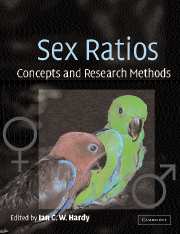Book contents
- Frontmatter
- Contents
- List of contributors
- Preface and acknowledgements
- Part 1 Sex ratio theory
- Part 2 Statistical analysis of sex ratio data
- Part 3 Genetics of sex ratio and sex determination
- Part 4 Animal sex ratios under different life-histories
- Part 5 Sex ratios in plants and protozoa
- Chapter 15 Sex ratios of malaria parasites and related protozoa
- Chapter 16 Sex allocation in hermaphrodite plants
- Chapter 17 Sex ratios in dioecious plants
- Part 6 Applications of sex ratios
- Index
- References
Chapter 17 - Sex ratios in dioecious plants
Published online by Cambridge University Press: 06 August 2009
- Frontmatter
- Contents
- List of contributors
- Preface and acknowledgements
- Part 1 Sex ratio theory
- Part 2 Statistical analysis of sex ratio data
- Part 3 Genetics of sex ratio and sex determination
- Part 4 Animal sex ratios under different life-histories
- Part 5 Sex ratios in plants and protozoa
- Chapter 15 Sex ratios of malaria parasites and related protozoa
- Chapter 16 Sex allocation in hermaphrodite plants
- Chapter 17 Sex ratios in dioecious plants
- Part 6 Applications of sex ratios
- Index
- References
Summary
Summary
Some seeds of dioecious plants develop into male plants and others become females. Brothers and sisters can grow close together in the seed shadow of the maternal plant, which promotes sib-mating, and classical sex-allocation theory predicts a slight female bias among the seeds produced. We describe different ways of examining seed sex ratios and some of the pitfalls involved. The available direct (seed sex ratio) and indirect (proportions of male and female plants in the field) evidence suggests that the seed sex ratio is often close to 0.5, despite the fact that there is genetic variation in the seed sex ratio in some cases. The combination of significant sib-mating and an unbiased seed sex ratio is at odds with classical sex-allocation theory. Genetic conflict theory might provide new insights and should be a central theme in future research. The adult sex ratio can also become male or female biased due to sexually differential mortality, but this does not influence the seed sex ratio.
Das Zahlenverhältnis [0.5] kann aber nur dann rein herauskommen, wenn eine ganze Reihe von Bedingungen erfüllt sind.
The ratio [0.5] can, however, only emerge, when a whole range of conditions is satisfied.
(Correns 1928)Introduction
Like most animals, but unlike the great majority of plant species, dioecious plants have separate male and female individuals. Both male and female organs develop in each of their flowers, in separate floral whorls, but the development of one type is halted before maturity (Grant et al. 1994), with the timing of the arrest differing between species.
- Type
- Chapter
- Information
- Sex RatiosConcepts and Research Methods, pp. 349 - 364Publisher: Cambridge University PressPrint publication year: 2002
References
- 17
- Cited by



